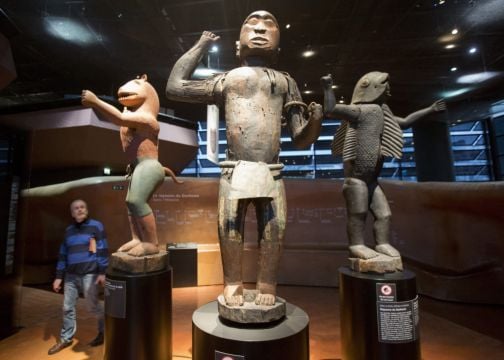A Paris museum is displaying 26 looted colonial-era artefacts for one last time before France returns them home to Benin.
The wooden anthropomorphic statues, royal thrones and sacred altars were pilfered by the French army in the 19th century from Western Africa.
President Emmanuel Macron has suggested that France needs to right the wrongs of the past, making a landmark speech in 2017 in which he said he can no longer accept “that a large part of many African countries’ cultural heritage lies in France”.
This laid down a roadmap for the controversial return of the royal treasures taken during the era of empire and colony, a move that could have potential ramifications across European museums.
The French will have a final glimpse of the objects in the Musee du quai Branly–Jacques Chirac from October 26-31.
French culture minister Roselyne Bachelot tried to assuage jitters among European museums, emphasising that this initiative “will not create a legal precedent”.
A French law was passed last year to allow the restitution of the statues to the Republic of Benin, as well as a storied sword to the Army Museum in Senegal.
But Ms Bachelot said that the French government’s law was intentionally specific in applying solely to the 26 artefacts.
“(It) does not establish any general right to restitution” and “in no way calls into question” the right of French museums to hold on to their heritage.
Du 26 au 31.10, les 26 œuvres restituées à la République du Bénin sont présentées au public avant retour dans leur pays d’origine dans l’exposition "BÉNIN, la restitution de 26 œuvres des trésors royaux d’Abomey" lors d’une semaine événementielle dédiée.
👉https://t.co/9t33lTd86X pic.twitter.com/GniFw0wYAN— musée du quai Branly - Jacques Chirac (@quaibranly) October 22, 2021
Yet critics of such moves – including the British Museum, which is in a decades-long tug-of-war with the Greek government over a restitution of the Elgin Marbles – argue that it will open the floodgates to emptying Western museums of their collections.
Many are made up of objects acquired, or stolen, during colonial times. French museums alone hold at least 90,000 artefacts from sub-Saharan Africa.
The story of the “Abomey Treasures” is as dramatic as their sculpted forms.
In November 1892, Colonel Alfred Dodds led a pilfering French expeditionary force into the Kingdom of Danhome located in the south of present-day Benin. The colonising troops broke into the Abomey Palace, home of King Behanzin, and seized many royal objects including the 26 artefacts that Dodds donated to the Musee d’Ethnographie du Trocadero in Paris in the 1890s.
Since 2003, the objects have been housed at the Musee du quai Branly–Jacques Chirac.
One hundred and twenty nine years later, their far-flung journey abroad will finally end.
Benin’s culture minister Jean-Michel Abimbola called the return of the works a “historic milestone”, and the beginning of further cooperation between the two countries, during a news conference last week.
The country is founding a museum in Abomey to house the treasures that will be partly funded by the French government.
The French Development Agency will give some 35 million euro (£30 million) toward the “Museum of the Saga of the Amazonians and the Danhome Kings” under a pledge signed this year.
The official transfer of the 26 pieces is expected to be signed in Paris on November 9 in the presence of Mr Macron and the art is expected to be in Benin a few days later, Mr Abimbola said.
While locals say the decision is overdue, what is important is that the art will be returned.
“It was a vacuum created among Benin’s historical treasures, which is gradually being reconstituted,” said Fortune Sossa, President of the African Cultural Journalists Network.







